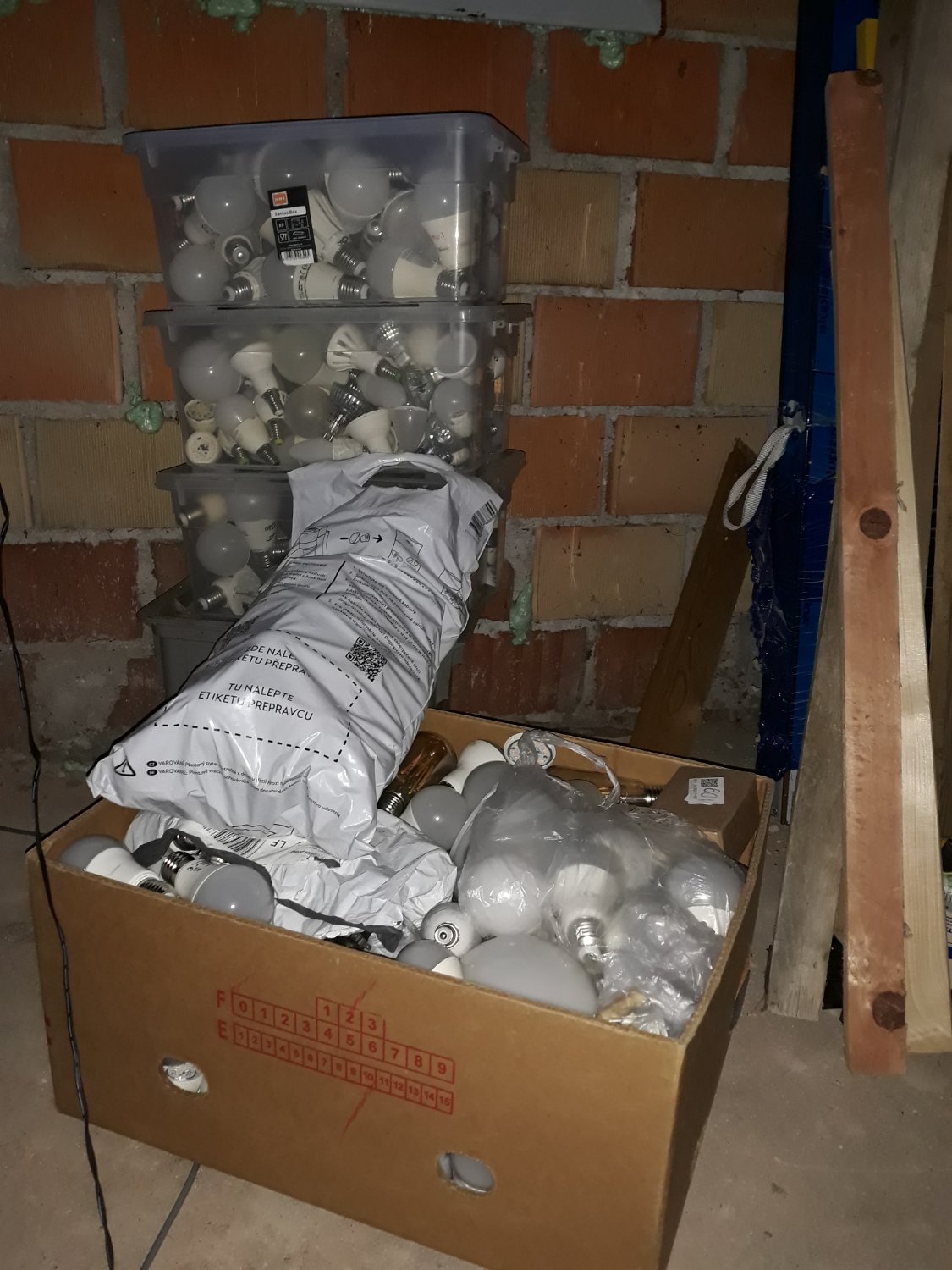How come LED Light Bulbs only last for about 2-3 Years?
I’ve bought and replaced a lot of light bulbs, and I noticed that all of them said “up to 20,000 hours” which would be about 5 years given 12 hours of daily use (which we definitely don’t).
My smart LED bulbs don’t even say how long they last, but my experience with LEDs in general tells me they will last practically forever. Out of all the LED things I have, the only ones with any burnt out lights are a couple of cheap LED strips I have and I can’t even be sure the ones that are dead weren’t because of where I cut the strip. I’ve had those things for over 12 years now and they’re in my PC which is always on.
Afaik, the biggest threat to killing the LED is heat, and some cheaper LED bulbs have really poor heat dissipation. Technology Connections has a video about them, which may be more informative.
I’ve had sets of LED under-cabinet lights powered on 24/7 for about 14 years. I think one bulb went bad, out of 12.
They are probably very low-power and don’t get hot, which would kill them faster.
What are the brands? What are the appliances? Have you tested the electricity coming out of those ports?
Mine are generally good for near 5
Generally because you’re buying cheaper ones that aren’t built as well. Heat destroys LEDs and the cheap bulbs generally use fewer individual LEDs running at higher power to produce a given output in lumens. More expensive bulbs use more LEDs at lower power to achieve the same light output so that they’re not constantly being overdriven and last much longer.
What would you recommend?
I have dozens of Philips Hue bulbs 6-10 years old and I honestly don’t think one of them has died. I’m sure they have lost some luminance over time, but they still get the job done no problem. I rarely run them at 100% anyway.
But yeah I have also had some cheaper LED bulbs die within a few years.
Can confirm
Just fyi for anyone who would care about this: while hue bulbs are built well they are moving towards a model that requires you to put them on “the cloud”, even though they were sold for years and years without that requirement. The update will be mandatory whether you want it or not as part of Philips security being integrated into the app. It’s unclear what will happen if you don’t create an account and sign in at that point
So if you’re like me and put all your iot shit on an isolated vlan without internet access they may not be the best option for you. Or if you just don’t want to support a company that wildly changes the tos years after purchasing their (expensive) product. I don’t want my home shit on the internet, I don’t trust Philips to put enough cash or effort into securing their servers, etc.
The bulbs do work with zigbee though and that seems to be a viable alternative to using their hub/app although I haven’t tested it fully. This also means if you’re using them via HomeKit you’ll need some kind of bridge like home assistant
I added all my 10 year+ Hue bulbs to a zigbee stick about 4 years ago. I control them with Home assistant and Zigbee2mqtt. They were a bit flakey at first but after awhile now with updates they have been flawless. Best thing is you still get firmware updates through z2m. Highly recommend using Hue bulbs for their long term support and quality. I have had 1 bulb start flickering and Hue actually replaced it, free of charge.
That’s good to hear. I have a zigbee stick but haven’t found the time to repair them that way yet. I definitely agree they’re good products, it just left a real bad taste in my mouth when after years of using them I got a notification in the app that soon I’ll be required to put them online, which is nonsense
Phillips warm glow are my favorites after watching technology connections. They last, and they look just like incandescent bulbs as you dim them.
I just buy a cheap jumbo pack from Amazon. They’re like 15 bucks and last for years which is good enough for me.
Lighting a campfire
The bulbs themselves are amazing. There are good ones in cars and computers, the flash of phones etc.
The failure point is typically the electronic components that run or regulate it. And of course most companies want to sell more bulbs so they conveniently skimp on that stuff. So maybe the answer is a more expensive bulb that hopefully will last long enough to justify the extra cost?
What would you recommend that actually last long enough to justify the extra cost?
If you’re technically inclined, Big Clive has a tutorial for ‘fixing’ most bulbs not to overdrive the LEDs by removing or changing a single resistor. https://www.youtube.com/watch?v=5HTa2jVi_rc
Make sure to choose lamp fittings that don’t trap the heat.
If you can get a hold of Dubai Led bulbs, they are supposed to last extremely long
https://hackaday.com/2021/01/17/leds-from-dubai-the-royal-lights-you-cant-buy/
What would you recommend?
Philips.
I still buy more halogen bulbs than LEDs - 4 fixtures in one room that I haven’t been able to convert go through more bulbs than the rest of the house of LED fixtures combined.
So far I haven’t bought any bulbs this year and have used only halogens, but I used up my stock of both.
My only real complaint about replacing LED bulbs is they change design more frequently than they need to be replaced - If I need to replace one bulb in a fixture, I can never find an exact match
Typically it’s not the emitters – the LED’s themselves – that fail. If driven correctly, those have lifetimes of tens of thousands of hours. That’s what the manufacturer is advertising on the box. Yes, an individual LED when driven correctly will probably last 20,000 hours. (Usually more, depending on how pedantic you want to get. The 20,000 hour figure often quoted is the point where the emitter drops to 80% of its original light output.)
LED “bulbs,” the type that replace filament bulbs in consumer fixtures, typically fail in their driver hardware. LED’s run off of low voltage DC and in the base of all of those LED conversion bulbs is a power conversion assembly that steps down and rectifies 120v/240c AC to whatever DC voltage the LED array in there expects. These are inevitably made out of whatever the cheapest passives and semiconductor components the manufacturer thinks they can get away with. These don’t last 20,000 hours, especially not in where they’re usually installed.
The main killer for all semiconductor electronics, which includes both LED’s themselves and their driver circuitry, is heat. This is often exacerbated by the fact that LED replacement modules are usually stuck in enclosed light fixtures designed for filament bulbs that have insufficient ventilation to get rid of the waste heat from the components in an LED module. The insides of those enclosed ceiling light fixtures, the ubiquitous “boob light,” gets hot, even with only LED modules installed. Filament bulbs don’t care because they don’t have any electronics in them and how they work is literally by getting so hot the glow. But LED modules in that kind of environment will invariably suffer an early failure.
Excellent.
Also, the D stands for diode, which is a one-way passage for electricity, some rectifiers may use diodes in their circuitry. So another way to cut costs is to not rectify completely or well.
Case in point, cheap LED Christmas lights are often not rectified at all so they flicker at 50/60 Hz depending on your country’s electrical supply…
I freaking hate that flicker so much. I can always tell when someone has done a cheap aftermarket headlight conversion because I’ll see the flicker out of the corner of my eye and my rearview mirrors and it’s incredibly distracting.
Slightly different. The alternator on a car has a very variable frequency due to change in engine speed and it’s fed into the car’s regulator/rectifier, so the typical power supplied is stable. However, many cars will use the high beams at half-power to function as daytime running lights (DRLs). This is usually done by pulse width modulation (PWM) meaning it’s chopping up the power supplied at a nearly imperceptible speed. An incandescent bulb will have so much fade time that the choppy power will go unnoticed. From there, theses two possibilities that cause the bulb to flicker. Very cheap bulbs will show their choppy power supply directly by flickering, making them noticeable as the move across your vision. Some mid-range bulbs will have cheap smoothing circuits (since vehicle power is “dirty”) so there will be charge time and discharge time as the capacitors charge up and down, allowing and disallowing the emitter to light, creating a slower flash pattern. Higher end bulbs (ignoring the part where their beam pattern is still usually trash) should be able to accommodate the chopped power and run dimmer.
You may also notice a similar flicker on LED tail lights where the brake light is a brighter tail light instead of a dedicated element. Such cars will use PWM for dimming and may flicker as they move across your view as well. Some of my car’s dash uses LEDs for backlighting and dimming the dash is done via PWM. If I glance across the steering wheel from side to side, it looks like “cruise” gets stamped across the view
are there cool/non-warm colored filament led bulbs? My SO prefers the cool colored bulbs.
I’d be shocked if there aren’t.
The same reason that filament based incandescent bulbs burned out. Planned obsolescence.
There’s a very real conspiracy (not just a theory) about the “arms race” in light bulbs for long lasting bulbs. Eventually, they made bulbs that lasted so long that they stopped making money.
Lighting manufacturers intentionally made worse bulbs to simply improve profits. They realized that they were driving themselves out of business. Everyone in the light bulb industry agreed to stop development of even longer lasting bulbs, just so they could continue to move units and make money.
Also, with LEDs, the thing that burns out fastest isn’t the LEDs (there’s usually a dozen… ish, in an LED bulb)… It’s the electronics. The power needs to be converted from line power to something the LEDs can handle, which is usually DC. So there’s a full power supply in the bulb to convert AC to DC, with a certain voltage to power the LEDs.
Sometimes this conversation is simple, a full bridge rectifier with little more than a filtering capacitor, other times it’s very complex.
The power supply in the bulb is usually what fails first.
Something to remember: thicker filaments, while they do last longer, worsen the ratio of light to heat.
This guy watched The Lightbulb Conspiracy… Am I right…?
Mine work for I think over 10 years now. Some of the actual LEDs inside died but you don’t really notice 1-2 of 200 inside the bulb being dark.
I have been dumpster-diving for LED bulbs for 5 years. None of them had 200 chips, they usually have about 5-30 packages with 1-6 diodes each for a total of around 30-60 so that they total some 90-180 V in series (I live in a 230V mains region, and the 330V rectified mains can be efficiently transformed to that voltage by an SMPS). Because they are in series, if one in the series chain fails open circuit (the most common way), the entire chain goes out. Yes, fixtures (not bulbs) with 100+ LED chips exist and if they are designed to operate at a low voltage with all chips in parallel, the failure of one will not affect the others.
This sounds like an interesting hobby? Care to share more about how/why you are into dumpster diving for lightbulbs?
I saw Big Clive and DiodeGoneWild take some apart, and we had been using halogen or fluorescent ones at home because LED bulbs were over $10 back then. I thought I would learn something about electronics but not really, the failure modes are always the same: about 50% of the time, an LED burns out. 25% of the time, it’s the smoothing inductor gone open circuit. 10% of the time, a bad contact somewhere (usually solder joints on linearly-regulated ones). 5 % work out of the box for some reason. I remain adamant about not paying for LEDs even though dumpster diving is objectively not worth the trouble anymore.

I have had the same light bulbs since 2012. One of them broke when I dropped it while moving. Otherwise, no issues at all. Philips brand that I bought a box of 12 of when I moved into an apartment that year. Maybe I’m just lucky, but still no issues.
FWIW, I’ve killed a bunch of Phillips hue bulbs through normal use
Can’t actually remember when or if I had a LED bulb die on me yet. Knock on wood …
My experience has been that they last for more years than I tend to notice which ones are which. I’m not mad at all about their longevity.
I had 2 LED bulbs that I know for sure that I bought prior to 2015 that only recently failed. Those bulbs lasted at least 9-10 years. The rest of my bulbs I haven’t kept up with but those 2 older ones looked very distinctive with aluminum heatsink material for their bottom halves.










